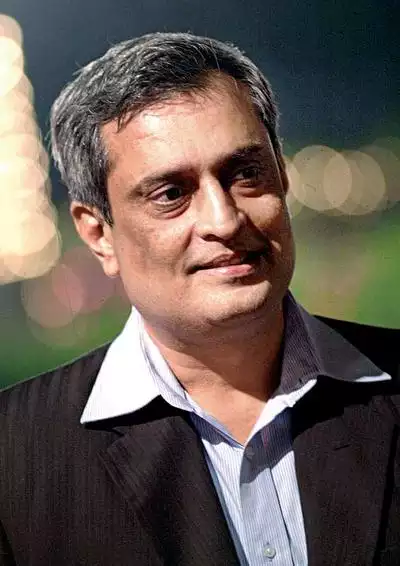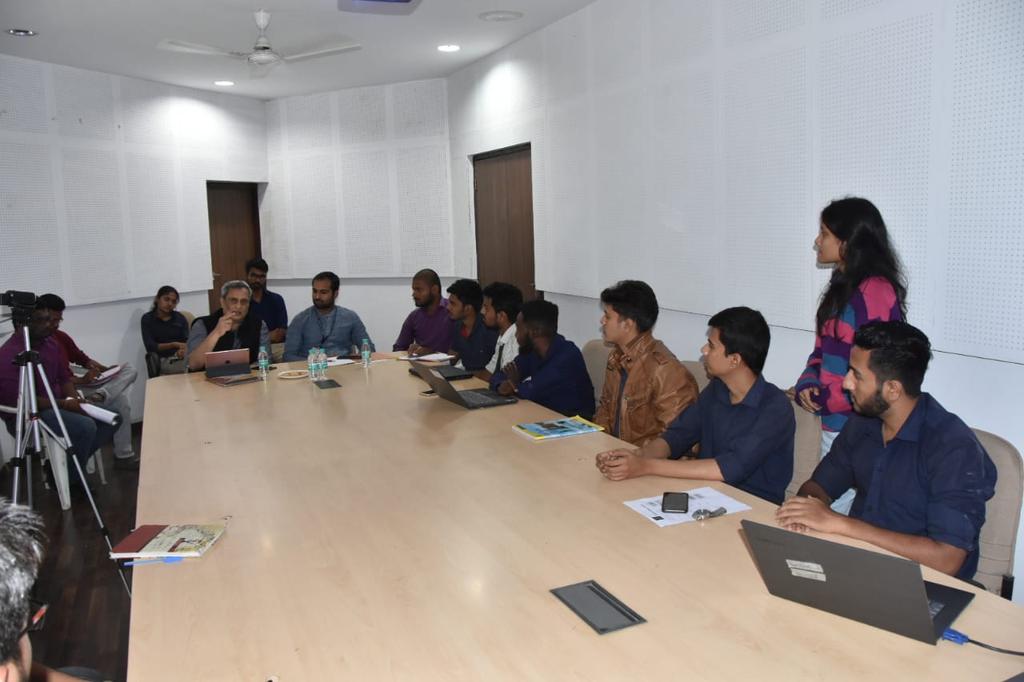Shashikant Chaudhary is a name synonymous with entrepreneurship and innovation, recognized as an early pioneer in technology in Maharashtra. As we have often seen, behind every celebrated success story lies a remarkable journey. When Chaudhary embarked on his own, he could hardly have foreseen the exhilarating highs and the challenging lows that awaited him.
His journey was fueled by unwavering determination and belief in his own abilities. Shashikant Chaudhary found his greatest support within himself, forging a path where there was none before. Today, he stands as an eminent serial entrepreneur, angel investor, and the mind that has led ten different companies. His presence in the entrepreneurial landscape remains as potent as ever; a testament to his enduring passion and drive for innovation.
But where did this extraordinary journey begin? What pivotal moments shaped the trajectory of Shashikant Chaudhary’s entrepreneurial odyssey? To unravel the origins of his remarkable career, we delve into the tale of a man who turned his dreams into reality against all odds.
Early endeavors in sports and business
Growing up in a middle-class family, Shashikant Chaudhary was a decent student (a top ten but never the top as he put it) with a rich background in sports; playing and competing in a variety of sports at the state level and beyond. In 1979, he started his bachelors in Electrical and Electronics Engineering from Visvesvaraya National Institute of Technology (VNIT), Nagpur. Despite selecting engineering as his field of study and no family background in the domain, Chaudhary had aspirations towards a new sector for him: business.

This newfound interest gave birth to his first business venture, an amalgamation of his passion for photography with business. Expectedly, not only did this small venture cover the necessary pocket expenses of a student, but it also proved to be fun as he was doing something he loved. This experience proved beneficial, and after graduation, Chaudhary immediately started his first company in 1984 – Malleable & Grey Iron Casting.
Above everything else, Chaudhary was a hard worker and, in parallel, worked on his MTech as well. A young aspirant with senior leaders around him, everything was smooth sailing and seemed to only be getting better, until one mistake upended the playing field completely.
Tragedy strikes
At the end of 1985, as Chaudhary had just married and was looking at promising prospects in life, tragedy struck. The thriving 300-person company he was part of came crashing down and closed in 1986. As many young companies often do, Chaudhary’s first venture also fell prey to the classical mistake of using the working capital for expenditure. Loans were not easy to come by, and the entrepreneurs were none the wiser.
The worst mistake was that the company had signed personal guarantees, which led to a flurry of back-and-forth court cases. Suddenly the scenic weather had turned into a gathering storm, which hit Chaudhary and his colleagues as hard as one would expect. Some founders attempted to commit suicide, one even succeeded; the young entrepreneur was left desolate in an environment where every likelihood seemed confusing and a dead-end. Still, when one finds himself stranded in the middle of nowhere with no sense of direction, sometimes the best solution is pushing yourself to keep walking forward.
Chaudhary’s childhood in sports taught him to never back down, despite repeated losses and failures. Additionally, this failure was a major learning opportunity. His family’s support, as well as unwavering and unconditional support of his wife, Minal, helped him immensely. In a situation like this, one’s flight and fight responses activate, and he chose to fight.
“When one grows up in a protected environment, their response mechanisms to failures are not mature, and you tend to react to the situation. Fortunately for me, I was in multiple sports, and the cycle of failing and coming back and taking it all in my stride helped me stay part of the game,” Shashikant Chaudhary relayed in an interview with The Story Watch.
Rising from the Ashes – The rigorous plan to restart his entrepreneurial journey
Shashikant Chaudhary knew that he was the only one who could uplift himself. One of his major lessons from the setbacks was that people might be sympathetic, but they have their own set of issues to deal with; this in turn also proves no one dissects your failures more than you do yourself.
With the next venture, Chaudhary had made up his mind that he would work as a single founder. He believed that if he got successful in an individual venture, he could prove his capabilities to society. In 1986, IT was just coming into focus, and he set his sights on it. Still, this was an unexplored field, and he lacked both academic background and experience.
Despite the odds, his rationale behind tackling this issue was fairly simple and propelled by his core philosophy: “You need to count years into hours”. Every domain has people with varying years of experience, but did he really need to spend another 4-5 years learning to get the necessary knowledge? While we tackle multiple subjects in college, everyone usually only specializes in one. Chaudhary knew that through simple hard work, he could compress these years into hours. 200 hours spent on the area of specialization and an additional 500 hours compensating for the field experience. The tangibility of these hours gave him confidence, and he selected the frame of CAD and civil engineering.
With rigour and utmost discipline, he spent 15–16 hours every day learning the ropes, and within a mere 6 months, he had put in over 3000 hours of handwork—four times more effort than any student studying this domain in college. This gave him the conviction that he could beat the system.
A revered name in the IT field
As one would expect, his dedication paid off, and once proficient, he started driving the system from the top, being one of the very rare people back then to specialize in computers. Soon Chaudhary became a revered figure in the IT field; many called him the ‘guru’ of CAD and civil engineering. Even when the market was slow, he wasn’t worried at all due to the respect he had garnered in the field.
While heading the Computer Technology Department at YCCE, Nagpur, Chaudhary knew he could now look at the bigger picture. In 1997, he approached one of the college founders to extract the complete potential of his students while utilizing the rising importance of computer technology. He started four companies, like E-Forum System, ADCC Infocad, ADCC R&C and ADCC Consultancy, in the span of just two years. He was the de facto CEO of all these companies, and by 1999, they boasted an employee base of 300 people and had a turnover of Rs. 25 crore.
At this point, any keen observer could predict the next tangent for Chaudhary. With a steady philosophy that did not fear failure and a never ending drive, he undertook the task of setting up another venture and established Lambent Technologies with 4–5 of his students. To calm the restless minds of his young students/employees and to ensure bigger and better things; Chaudhary knew that Lambent needed to be focused, unlike the past four companies, which were somewhat fragmented in their offerings. Lambent Technologies only focused on software services in the US, where the margins were higher.
A journey with a learning curve at every step
Lambent Technologies, under Chaudhary’s visionary leadership, stood out as a unique venture of its time. Despite being situated in Nagpur, a non-metropolitan area, the company worked diligently to establish its reputation. Moreover, the five to seven people who made up the team were mostly young graduates still trying to find their footing in the industry.

The entrepreneur, relying on his first principles approach, created a new mechanism for that suited the team building effort he was undertaking. Even with an Employee Stock Ownership Plan (ESOP), instead of just focusing on the option to buy the stock, he created the option to sell the stock. This risky move resonated with an employee base of young people. If the company takes off; 50% of the investments will be for the company, and the rest will be for the employees. He gave the employees the option to sell part of the stock every six months if the company did well. Along with their salary, in three years, he will give them six opportunities to sell the 10% stock each employee had recieved.
“I said to them, You can go to any big company and you can be project manager, senior project manager, etc. in 4-5 years among 30 thousand, 50 thousand, or 1 lakh people. But if you work in this company and make it big in India and Nagpur, you will be the kind of people who’ll be remembered to set up a legacy,” relayed Shashikant Chaudhary.
He only needed belief in his vision. He knew that working for a young company would expose employees to not only the latest technologies but also different aspects of their business. Additionally, he said that the venture has to create substantial financial return in 5 years apart from stock options and regular salary. Chaudhary’s mentorship was both visionary and dependable; he assured employees that in case things didn’t work out, he’d personally assist them in finding good jobs through his connections.
Another kink in the road
As Chaudhary was working to uplift Lambent while simultaneously looking for more profitable areas, a friend from Switzerland recommended that he tackle straight-through processing (STP). While tech was in demand to process payments at the T+0 timeline, Chaudhary had never explored the financial industry. Yet determined to take this in stride too; he placed three employees in Switzerland to make them learn the nuances of tech and the financial industry.
Back in India, he hired a team of 5–6 financial experts to navigate the industry and create a deeper integration of product and the market. All seemed smooth-sailing until the infamous 9/11 attack in 2001. The disaster caused all of Chaudhary’s initiatives to come crashing down. As Lambent’s business in the US fluctuated as well, the company suffered a loss of both time and revenue, with more than Rs. 1.5 crore lost and an year of company resources spent on the initiative.
Conquering the battlefield
Hit with another setback, Chaudhary was again left to ponder the alternatives. However, inspiration came unexpectedly, as it often does. While attending a housewarming party in Boston, a friend handed him a book about marketing warfare. For Chaudhary, this proved to be a big turning point in his life. A section of the book interestingly hypothesizes that while actual wars are fought for land-grabbing, corporate wars are fought for mind-grabbing.
“It relayed how a small power cannot expect to win the war, but they can expect to win a battle in that war, provided that you choose the battle field in such a manner that you attack the enemy at his weakest point with your strongest force. This gave rise to my own philosophy: “Winning a war is a choice, but losing a battle is not an option”, said Shashikant Chaudhary about the inspiration.
Now rigorous to win the battle even if he lost the war; he realized that his new initiatives should be technology-based instead of domain-based. Industry giants like TCS and Wipro were figuring out new technologies as well, and Chaudhary knew that putting in resources to explore these technologies would help him win the small battle. Taking inspiration from a big player like Qualcomm, he decided to focus on the rising BREW software. He knew that if a big player was pushing for it, the market would soon navigate there in the coming years.
The decision was set with a clear entry and exit strategy for the domain in mind. The innovator worked tirelessly, wresting contracts for gaming applications from giants like Wipro. Soon enough, Lambent was working with big names like Sony Pictures, Sony Movies, Gameloft, and Electronic Arts.
Leaving the corporate work: a mentor above all else
With the battles won, Chaudhary knew that he could leave the wars to the big corporations. This led to the merger of Lambent Technologies with Induslogic, which guided the creation of Globallogic Technologies. Induslogic was a 1,000 people strong team when Lambent merged with them. Post the merger, the company went on to grow to 10,000 people, with Shashikant serving as the Managing Director of India. An experienced entity in the game, the company was deploying services to more than 250 companies like Google, LinkedIn, Intel, Microsoft, Verizon, Samsung, Boing, Sandisk, etc.
In 2013, after Globallogic was seamlessly acquired by Apax Partners, Chaudhary, now in his 50s, left the arena and turned his attention to yet another emerging sector: startups. Wanting to mentor and hone young entrepreneurs in Nagpur, he made his first investment in 2013. Shortly thereafter, he created and started teaching innovative courses at VNIT.

By that time, he had already invested 30 companies. He was an early figure in Blume Ventures Funds I, II, and IIFL. He was also the president of TiE Nagpur; the world’s largest not-for-profit organisation devoted to fostering entrepreneurship with 15000 members in 56 chapters across 14 countries. Above everything else, startup mentoring called to Chaudhary’s personal interest in teaching and helping new talent. He started Vidarbha Angels to connect young local startups to investors. He also created a mechanism to fund VNIT Alumni led startups, and so far has helped fund 5 companies via this initiative.
“There were no senior people to teach us when we started our journey, to give mentoring or advice; there was no structured or unstructured path. I felt this was where I had something I could give back. I could be helpful to them not just in teaching but giving a place to play out and grow. When I see a company I mentored and invested in making strides, that is satisfaction,” Shashikant Chaudhary shared about his special interest in teaching with The Story Watch.
Conclusion: The road ahead for this unrelenting player
In 2020, with COVID right around the corner, the innovator set his sights on yet another unexplored zone: infant care. He wanted to create a safe space that guided parents through the crucial early years of their baby’s life. He co-founded the company Babyverse.app to help parents manage nutrition, sleep and learning easily.
This was Shashikant Chaudhary’s 10th venture and the first time exploring the B2C space. Despite all this, he had reached a stage in life where he was not afraid of failure at all; he knew he had it in him to take it all in stride. With the vigour to solve another big problem while learning simultaneously, BabyVerse was officially launched in 2022.
Working tirelessly towards another path, Shashikant Chaudhary proves that all one needs is determination; the fight to never back down and never give up. When the entrepreneur encountered his first setback at an age where failure can hit the hardest, he chose to painstakingly work towards his goal and prove himself. Today, Chaudhary is a seasoned and respected veteran in the IT and investment sphere, with a vigour to mentor and guide young talent.
Join The Story Watch’s initiative to create a vibrant community for the startup ecosystem.

